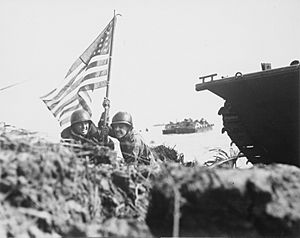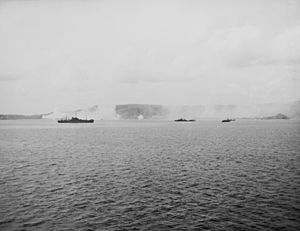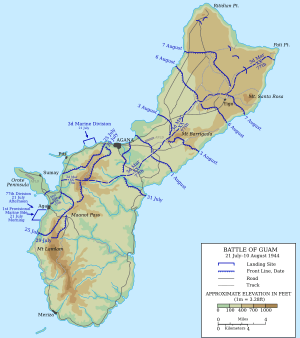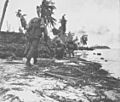Battle of Guam (1944) facts for kids
Quick facts for kids Second Battle of Guam |
|||||||
|---|---|---|---|---|---|---|---|
| Part of World War II, Pacific War | |||||||
 Two U.S. servicemen plant the American flag on Guam eight minutes after U.S. Marines and Army assault troops landed |
|||||||
|
|||||||
| Belligerents | |||||||
| Commanders and leaders | |||||||
| Strength | |||||||
| 56,000 | 18,500 | ||||||
| Casualties and losses | |||||||
| 31,987 killed, 6,053 wounded |
18,040+ killed, 485 POWs |
||||||
The Second Battle of Guam (July 21 — August 10, 1944) was when the United States took back the island of Guam from Japanese control. Guam is a U.S. territory in the Mariana Islands. This important battle happened during the Pacific part of World War II.
Contents
Why Guam Was Important
Guam is the biggest island in the Mariana Islands. It is about 30 miles (48 km) long and 9 miles (14 km) wide. The United States had owned Guam since 1898, after taking it from Spain.
However, Japan captured Guam on December 10, 1941. This happened soon after the Attack on Pearl Harbor. Guam was not as strongly defended by Japan as other nearby islands like Saipan.
The Allied forces planned to invade the Marianas. Their plan was to bomb the islands heavily from planes and then from battleships.
Guam was a key target because it was large enough to be a good base. From Guam, the Allies could launch future attacks on the Philippines, Taiwan, and the Ryukyu Islands.
The harbor at Apra could hold very large ships. Also, Guam had two airfields big enough for B-29 Superfortress bombers.
The invasion of Saipan was set for June 15, 1944. The landings on Guam were planned for June 18. But a big Japanese carrier attack and tough fighting in Saipan caused the Guam invasion to be delayed for a month.
The Battle for Guam
Guam is a difficult island to attack. It has many reefs, steep cliffs, and strong ocean waves around it.
American Landings
On July 21, American troops landed on the western side of Guam. The U.S. 3rd Marine Division landed at 8:28 AM. The 1st Provisional Marine Brigade landed to the south of them.
Japanese artillery fired at the landing ships. They sank 20 Landing Ships. Many Americans were killed or wounded during these landings.
By 9:00 AM, soldiers and tanks were on both beaches. The 77th Infantry Division had to walk through shallow water. Japanese guns kept firing at them.
By the end of the first day, the Americans controlled the beaches. They had pushed inland about 2,000 meters. The Japanese launched attacks throughout the first few days to try and push them back.
Japanese Resistance
On July 28, the Japanese commander, Lieutenant General Takeshi Takashina, was killed. Lieutenant General Hideyoshi Obata then took over command of the Japanese defenders.
Getting supplies was very hard for the Americans in the first days. But the Japanese faced even bigger problems.
The constant attacks on the American beaches and the fierce fighting had worn out the Japanese soldiers. By early August, they were running low on food and ammunition. They also had very few tanks left.
General Obata moved his remaining troops to the mountains in the center and north of the island. He could not get any more supplies or new soldiers. This was because the Americans controlled the sea and air around Guam.
The Japanese soldiers refused to give up. Almost all of them fought until they were killed. On August 10, the U.S. captured Guam. The next day, General Obata committed ritual suicide.
After the Battle
After the battle, a few Japanese soldiers hid in the jungle. On December 8, 1945, three U.S. Marines were killed by these hidden soldiers.
On January 24, 1972, a Japanese sergeant named Shoichi Yokoi was found by hunters. He had lived alone in a cave for 27 years, not knowing the war had ended.
After the battle, Guam became a major base for Allied operations. Five large airfields were built by the Seabees. From these airfields, B-29 bombers flew missions to attack targets in the Western Pacific and in Japan.
Four U.S. Marines received the Medal of Honor for their brave actions during the Battle of Guam:
- PFC Luther Skaggs Jr.
- PFC Frank Witek (awarded after his death)
- PFC Leonard F. Mason (awarded after his death)
- Captain (who later became a General) Louis H. Wilson, Jr.
Liberation Day is still celebrated on Guam every July 21.
Images for kids
-
U.S. Marines move inland.
See also
 In Spanish: Batalla de Guam (1944) para niños
In Spanish: Batalla de Guam (1944) para niños







